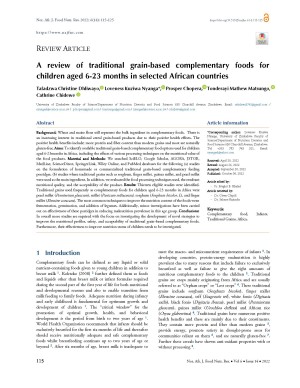Main Article Content
A review of traditional grain-based complementary foods for children aged 6-23 months in selected African countries
Abstract
Background: Wheat and maize flour still represent the bulk ingredient in complementary foods. There is an increasing interest in traditional cereal grain-based products due to their positive health effects. The positive health benefits include; more protein and fiber content than modern grains and most are naturally gluten-free.
Aims: To identify available traditional grain-based complementary food options used for children aged 6-23months in Africa, including the effects of various processing techniques on the nutritional value of the food products.
Material and Methods: We searched SciELO, Google Scholar, AGORA, JSTOR, MedLine, ScienceDirect, SpringerLink, Wiley Online, and PubMed databases for the following (a) studies on the formulation of homemade or commercialized traditional grain-based complementary feeding porridges, (b) studies where traditional grains such as sorghum, finger millet, guinea millet, and pearl millet were used as the main ingredient. In addition, we evaluated the food processing techniques used, the resultant nutritional quality, and the acceptability of the product.
Results: Thirteen eligible studies were identified. Traditional grains used frequently as complementary foods for children aged 6-23 months in Africa were pearl millet (Pennisetum glaucum), millet (Panicum miliaceum), sorghum (Sorghum bicolor. L), and finger millet (Eleusine coracana). The most common techniques to improve the nutrition content of the foods were: fermentation, germination, and addition of legumes. Additionally, minor investigations have been carried out on effectiveness of these porridges in reducing malnutrition prevalence in this age group.
Conclusions: In overall more studies are required with the focus on investigating the development of novel strategies to improve the nutritional profiles, safety, and acceptability of traditional grain-based complementary foods. Furthermore, their effectiveness to improve nutrition status of children needs to be investigated.







